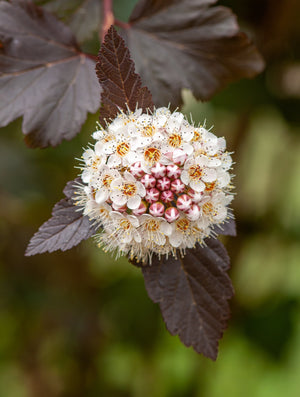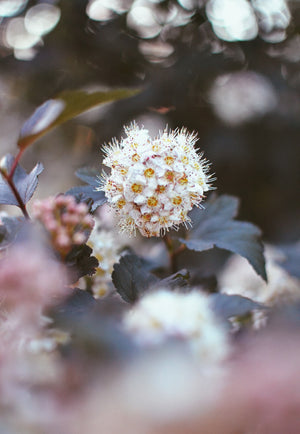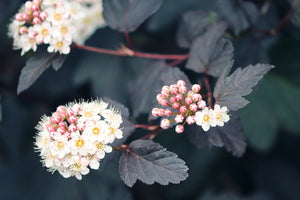The Ninebark Guide
Ninebark shrubs are a remarkable choice for elevating the beauty of your garden or landscape throughout the year. With their glossy, evergreen foliage and vibrant berries, they bring a stunning touch to any outdoor space. These resilient shrubs have the ability to thrive in diverse conditions, making them a versatile and low-maintenance option for your garden. Lets discover the enduring charm and effortless beauty of ninebark.

About
Ninebark, scientifically known as Physocarpus, is a genus of flowering deciduous shrubs native to various regions of North America. Renowned for their captivating beauty, they're widely cultivated for their ornamental value and can be found gracing landscapes, gardens, and parks. These shrubs exhibit an array of delightful features, including attractive foliage, delicate flowers, and intriguing bark texture, making them a popular choice among gardeners and landscaping enthusiasts.
Ninebark shrubs typically boast serrated leaves with varying colors, ranging from deep green to burgundy, offering a visually pleasing contrast. The flowers, which appear in spring or early summer, come in clusters and exhibit shades of white, pink, or red, adding a vibrant touch to the landscape. As the seasons progress, the blossoms give way to small fruit pods that add further visual interest.
Ninebark shrubs are known for their adaptability and can thrive in a range of growing conditions. They are generally resilient and can tolerate different soil types, including clay and sandy soils. These shrubs are also relatively low-maintenance, requiring minimal pruning to maintain their desired shape and size. Their versatility extends to sun exposure, as they can flourish in full sun to partial shade, although some varieties may exhibit better coloration in full sunlight.
With their abundant blooms, stunning foliage, and intriguing bark peeling, Ninebark shrubs are an excellent choice for adding texture, color, and year-round visual interest to any garden or landscape.

Planting
Planting and caring for Ninebark shrubs requires attention to their specific needs to promote their health and vitality. Consider the following guidelines when planting and maintaining your Ninebark shrubs:
Soil: Ninebark shrubs thrive in well-drained soil that is rich in organic matter. They prefer slightly acidic to neutral soil with a pH ranging from 6.0 to 7.0. If your soil is too alkaline, you can amend it with acidic materials like sulfur to adjust the pH accordingly.
Sunlight: Ninebark shrubs exhibit adaptability to various light conditions, from full sun to partial shade. When selecting a planting location, assess the amount of sunlight it receives throughout the day. Optimal locations provide some shade during the hottest parts of the day.
Watering: Regular watering is essential, particularly during the initial years of growth. Water deeply and thoroughly once or twice a week, adjusting the frequency based on weather conditions and soil moisture levels. Avoid overwatering, as excessive moisture can lead to root rot.
Mulching: Apply a layer of organic mulch around the base of your Ninebark shrubs to retain moisture and regulate soil temperature. Wood chips, bark, or compost make suitable mulching materials. Keep the mulch a few inches away from the shrub's trunk to prevent excessive moisture buildup.
Following these fundamental guidelines will ensure that your Ninebark shrubs thrive, adding beauty and charm to your landscape for years to come.

Care
Consider the following care guidelines to ensure that your Ninebark shrubs thrive and bring lasting beauty to your outdoor space:
Watering: Ninebark shrubs require moderate watering, aiming for about one inch of water per week, taking into account rainfall. During periods of drought or high temperatures, more frequent watering may be necessary to prevent stress and dehydration. Water deeply and thoroughly, encouraging deep root growth rather than shallow watering.
Pruning: Ninebark shrubs generally have low pruning requirements. However, it is recommended to remove any dead or damaged branches and shape the shrub to maintain its desired size and form. Pruning should be done in late winter or early spring before new growth emerges, using clean and sharp tools to avoid causing harm.
Fertilization: Promote healthy growth and foliage by fertilizing Ninebark shrubs. Apply a slow-release, balanced fertilizer in the spring or early summer, following the instructions provided by the manufacturer. Avoid over-fertilization, as it can harm the roots. If unsure, it is best to apply a little less fertilizer than recommended.
Soil and Sunlight: Ninebark shrubs prefer well-drained and moist soil. They are adaptable to different soil types but may require additional watering during hot and dry periods. These shrubs thrive in partial to full sun exposure, although they can tolerate some shade.
Pest and Disease Management: While Ninebark shrubs are generally resistant to pests and diseases, it is important to monitor them for common issues such as scale, mealybugs, and leaf spot. If any signs of damage or disease are observed, promptly treat the shrubs with suitable insecticides or fungicides.
By following these basic care guidelines, your Ninebark shrubs will flourish and provide lasting beauty for years to come.

How To Use
Harness the artistic potential of Ninebark to elevate your landscape with these creative and practical suggestions:
Focal Splendor: Make a bold statement by featuring Ninebark as a captivating focal point in your garden. Plant a cluster of these ornamental shrubs in an open area to showcase their unique foliage and vibrant colors. Experiment with different Ninebark varieties to create a dynamic display that evolves gracefully throughout the seasons, adding an elegant touch to your outdoor haven.
Edging Elegance: Define the edges of your garden beds with the grace of Ninebark. Their compact and bushy growth makes them ideal for creating borders that bring a touch of refinement to your outdoor space. Allow these versatile shrubs to weave a tapestry of color and texture along pathways or around other garden features, providing a visual frame that enhances the overall aesthetic.
Vibrant Hedges: Transform utilitarian features into eye-catching elements by using Ninebark to create lively and colorful hedges. The dense growth habit of Ninebark not only ensures privacy but also delivers a burst of visual interest. Regular shaping maintains a neat appearance, letting these vibrant hedges become living boundaries that redefine the aesthetics of your garden.
Container Brilliance: Dive into the world of creative container gardening by cultivating Ninebark in pots or containers. This allows you to add bursts of color to patios, decks, or balconies, as well as the flexibility to move these delightful shrubs to different areas. Experiment with various container sizes and shapes to customize your outdoor space, infusing it with the charm and versatility of Ninebark.
Companion Harmony: Combine the beauty and functionality of Ninebark by using them as companion plants. The vibrant foliage and distinctive flowers of Ninebark complement a variety of other plants. Integrate Ninebarks into mixed borders or group them with perennials to create visually pleasing and ecologically supportive plant communities, fostering a harmonious balance in your garden.
Whether you're aiming for a focal point, a border, a hedge, or a potted masterpiece, Ninebarks bring elegance and versatility to your landscape. Consider their moderate size, delightful foliage, and adaptability when planning your garden. With Ninebarks, you're not just landscaping; you're crafting a masterpiece that evolves with the seasons, adding a touch of sophistication to your outdoor haven.
Conclusion
In the symphony of landscaping, Ninebark emerges as a versatile and captivating shrub, composing a melody of colors, forms, and practical applications for your outdoor sanctuary. With its graceful demeanor and adaptable nature, Ninebark adds a refined touch to various garden settings, becoming an integral part of your horticultural narrative. From the delicate foliage of spring to the vibrant hues of summer and the warm tones of fall, Ninebark paints a living canvas that evolves with the seasons, ensuring your landscape is a perpetual work of art.
Beyond its visual allure, Ninebark plays a multifaceted role in your outdoor haven. Whether standing proudly as a standalone focal point, enhancing borders with its elegance, forming vibrant hedges, or gracing containers as a potted masterpiece, Ninebark seamlessly blends aesthetics with practicality. Craft privacy, define spaces, and elevate the charm of your garden, as Ninebark demonstrates that beauty can indeed serve a purpose.
A testament to its versatility, Ninebark makes an excellent companion to a variety of plants, thriving in mixed borders and complementing other perennials to create harmonious plant communities. With Ninebark as a key player in your garden ensemble, you're not merely cultivating plants; you're nurturing a balanced and flourishing ecosystem.
Embrace the ever-changing melody of your garden with Ninebark as a central theme. Its resilience and adaptability ensure that your landscape remains dynamic, responding harmoniously to the rhythm of the seasons. By incorporating Ninebark, you're creating an outdoor space that resonates with life, color, and the subtle charm of nature.
In the realm of garden design, Ninebark is not just a shrub; it's a living note in the melody of your landscape. With thoughtful planting, care, and creative deployment, this versatile shrub becomes the crescendo that elevates your outdoor space to a masterpiece. Nurture your garden with the dedication it deserves, and let Ninebark be the timeless refrain that brings you joy for years to come.
















